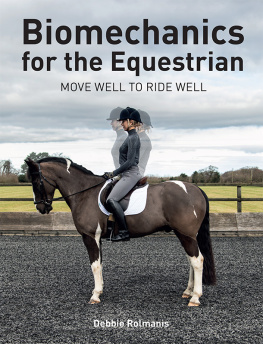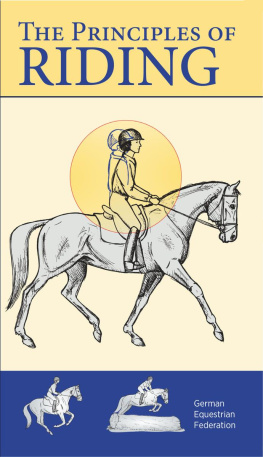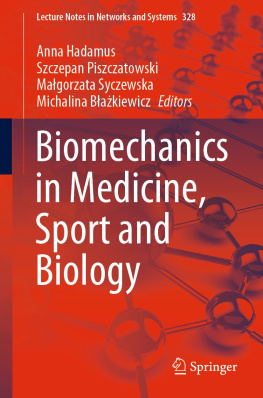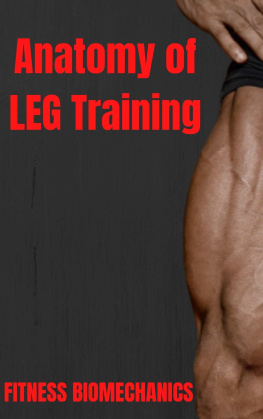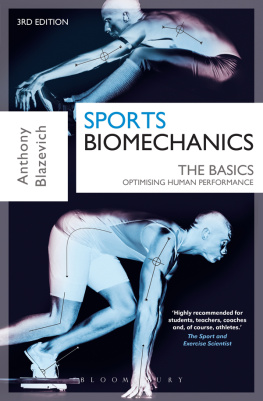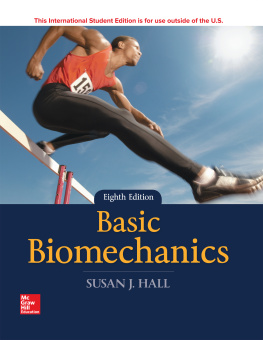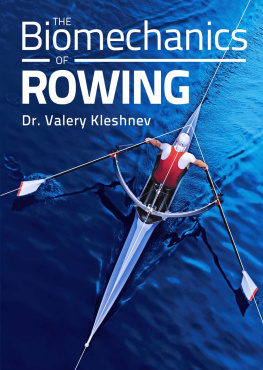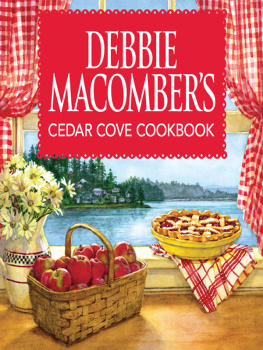Debbie Rolmanis - Biomechanics for the Equestrian : Move Well to Ride Well.
Here you can read online Debbie Rolmanis - Biomechanics for the Equestrian : Move Well to Ride Well. full text of the book (entire story) in english for free. Download pdf and epub, get meaning, cover and reviews about this ebook. City: La Vergne, year: 2019, publisher: Crowood, genre: Religion. Description of the work, (preface) as well as reviews are available. Best literature library LitArk.com created for fans of good reading and offers a wide selection of genres:
Romance novel
Science fiction
Adventure
Detective
Science
History
Home and family
Prose
Art
Politics
Computer
Non-fiction
Religion
Business
Children
Humor
Choose a favorite category and find really read worthwhile books. Enjoy immersion in the world of imagination, feel the emotions of the characters or learn something new for yourself, make an fascinating discovery.
- Book:Biomechanics for the Equestrian : Move Well to Ride Well.
- Author:
- Publisher:Crowood
- Genre:
- Year:2019
- City:La Vergne
- Rating:5 / 5
- Favourites:Add to favourites
- Your mark:
- 100
- 1
- 2
- 3
- 4
- 5
Biomechanics for the Equestrian : Move Well to Ride Well.: summary, description and annotation
We offer to read an annotation, description, summary or preface (depends on what the author of the book "Biomechanics for the Equestrian : Move Well to Ride Well." wrote himself). If you haven't found the necessary information about the book — write in the comments, we will try to find it.
Biomechanics for the Equestrian : Move Well to Ride Well. — read online for free the complete book (whole text) full work
Below is the text of the book, divided by pages. System saving the place of the last page read, allows you to conveniently read the book "Biomechanics for the Equestrian : Move Well to Ride Well." online for free, without having to search again every time where you left off. Put a bookmark, and you can go to the page where you finished reading at any time.
Font size:
Interval:
Bookmark:

Biomechanics
for the Equestrian
MOVE WELL TO RIDE WELL

Biomechanics
for the Equestrian
MOVE WELL TO RIDE WELL
Debbie Rolmanis

First published in 2019 by
by JA Allen
JA Allen is an imprint of
The Crowood Press Ltd
Ramsbury, Marlborough
Wiltshire SN8 2HR
www.crowood.com
This e-book first published in 2019
Debbie Rolmanis 2019
All rights reserved. This e-book is copyright material and must not be copied, reproduced, transferred, distributed, leased, licensed or publicly performed or used in any way except as specifically permitted in writing by the publishers, as allowed under the terms and conditions under which it was purchased or as strictly permitted by applicable copyright law. Any unauthorised distribution or use of this text may be a direct infringement of the authors and publishers rights, and those responsible may be liable in law accordingly.
British Library Cataloguing-in-Publication Data
A catalogue record for this book is available from the British Library.
ISBN 978 1 90880 985 8
Diagrams by Carole Vincer
Disclaimer
The author and publisher do not accept responsibility in any manner whatsoever for any error or omission, or any loss, damage, injury, adverse outcome, or liability of any kind incurred as a result of the use of any of the information contained in this book, or reliance upon it.
Introduction
Who wants to ride better? Who wants to move with less pain? Who wants to avoid a hip replacement? And who wants age to not be a barrier to all the things you love doing? Me! I want all those things! That is what I decided a few years ago and, working with riders of all levels, across a multitude of disciplines, I knew that these were things they wanted too.
I havent always been interested in how the body works. I was a sporty kid; not the worst on the court or in the pool or on a horse, but certainly not the best either. I didnt think twice about not being able to do things until I was thirteen and receiving physiotherapy for a broken collar bone (yes, I did fall off a horse) when I was diagnosed with congenital scoliosis. Apparently a couple of my vertebrae were incomplete, which had forced my spine to make the shape of a winding mountain road as opposed to the normal column that really would be preferable. For the first time I was made very aware of my body, especially on my one and only visit to the specialist who announced that I should never again get on a horse. Although I ignored him, it did awaken a curiosity in me and over the next few years I sought help from alternative therapies; I stuck with the ones who told me what I wanted to hear and continued my riding career. Subsequently I became a personal trainer; understanding how the body worked not only helped me to coach riders, but also to keep myself strong and mobile. By this point my interest in all things performance was well and truly entrenched and I went on to become a sports therapist for horse and rider to help unravel some body and performance issues.
I worked with riding clients of all levels, ages, shapes and sizes for over a decade, and patterns of dysfunctions common themes of pain, positional frustrations and horse training trouble appeared across the board. Elite riders would show up with the same physical niggles as amateurs and, although improvements were being made, niggling and insidious issues would continue. I knew I was missing something. Seemingly fit, active people were suffering with pain and dysfunction, which was impacting them both on the ground and in the saddle. The gap in my knowledge was understanding the bodys non-negotiable, indelible need for movement not movement in terms of a workout at the gym or a thirty-minute run, but consistent, varied, aligned movement of the entire body. The work I was doing was facilitating the opportunity for good movement, but the missing link was the actual good movement. As soon as a rider left my clinic, they would continue to move their bodies in the same way as they had on their way in. Little wonder their problems were recurring. The way the rider moved during their everyday life was impacting their body in the most significant way, and when I realized this, I noticed every rider I work with suffering with similar patterns.
Delving into the world of biomechanics, discovering how loads shape our bodies and how our bodies are designed to thrive from movement, has turned my practice on its head. It is now less about treatment and more about movement education. There is nothing more powerful than corrective movement done all of the time. Real change is only possible if the body is moved how it was designed to be moved, and it isnt about carving time out of your day to do it. Every rider I work with is time poor, so trying to stick to an exercise regime or time at the gym is often not practical and, as will become clear, is not necessarily the best for the body. Classes once a week can be really useful, but they can also present challenges to the body if it is turning up with muscle imbalances, immobility and vulnerable joints. Bringing a stable foundation to the exercise you want to do will give you greater results and provide you with more of a safeguard against injury.
Riding is complicated: we all know that, and every rider I know just wants to be better at it and keep their horse sound. The truth is that the body you bring to the saddle plays a massive role in dictating your riding journey. Everything you do in the saddle how you sit and where you sit will influence the way the horse loads his limbs, his back, his pelvis and his forehand. Adjusting your position in the saddle is fine for small tweaks, but the shape your body is in on the ground will be the same shape it will be in on the horse. That is to say, if you have a sore back, a stuck hip and a frozen shoulder on the ground, these will impact everything you do in the saddle and will dictate how your horse has to move. Knowing how to move yourself away from pain and dysfunction on the ground will change how you sit in the saddle; riding well doesnt just happen in the hours you spend riding: it happens in the way you walk the dog, pick out feet and drive the car. Nobody has a perfect body (just ask them), yet we all only get one for the duration of our life and we live in it all the time! Your body carries with it your past, present and future. As you will see, your ancestors left you with a blueprint of an exceptional machine and this book will help you unearth the body you probably never knew you had. The present shape of your body is different from what it once was. It is constantly in flow, which means you also have the power to control how your shape will change in the future. Educating yourself about your body is one of the greatest gifts you can give yourself and it is my intention with this book to give you the knowledge you need to love the body you are living in, both in and out of the saddle. This is the book that is going to show you how to move well to ride well.
Part 1
Your Movement Story
If you spend any time at all thinking about the human body, from what you see to what lies beneath your skin, chances are you will consider it as a collection of parts organs, tissues, systems and limbs that operate independently from each other and which largely perform tasks without a whole lot of input from you. However, if that were the case there probably wouldnt be a need for this book. The reality is your body responds to everything you provide it with, and it also responds to everything you dont provide it with in terms of nutrition, hydration, emotional well-being (stress, fear, anger) and movement. As an adult, you will be well versed with the basic needs of a human body: good nutrition from a healthy and well-balanced diet, sufficient daily hydration from clean, plain water (0.033ml for every kg of bodyweight if you werent sure) and most of you are probably all too aware of how stress doesnt always serve your body positively. What is rarely touted as a life-giving essential is the basic human need for movement. You might know you need to exercise, yes, but the prescribed hour a day at the gym, or a thirty-minute run, or a class once a week, or riding your horse (although better than not moving at all) is only one tiny chapter of your movement story; its similar to knowing you should eat your greens, but greens alone do not make a complete diet.
Font size:
Interval:
Bookmark:
Similar books «Biomechanics for the Equestrian : Move Well to Ride Well.»
Look at similar books to Biomechanics for the Equestrian : Move Well to Ride Well.. We have selected literature similar in name and meaning in the hope of providing readers with more options to find new, interesting, not yet read works.
Discussion, reviews of the book Biomechanics for the Equestrian : Move Well to Ride Well. and just readers' own opinions. Leave your comments, write what you think about the work, its meaning or the main characters. Specify what exactly you liked and what you didn't like, and why you think so.

